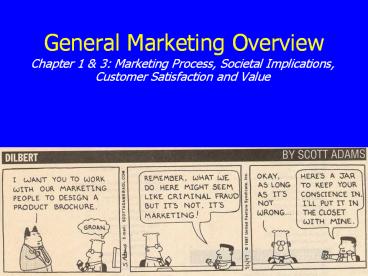General Marketing Overview - PowerPoint PPT Presentation
1 / 25
Title:
General Marketing Overview
Description:
General Marketing Overview Chapter 1 & 3: Marketing Process, Societal Implications, Customer Satisfaction and Value What is marketing? ????? What are your thoughts? – PowerPoint PPT presentation
Number of Views:112
Avg rating:3.0/5.0
Title: General Marketing Overview
1
General Marketing Overview
- Chapter 1 3 Marketing Process, Societal
Implications, Customer Satisfaction and Value
2
What is marketing?
- ??????? What are your thoughts?
- Create long term and mutually beneficial
exchange relationships between an entity and the
publics (individuals organizations) in which it
interacts - Create, sustain, maintain or add VALUE!
3
What is Marketing?
- American Marketing Association Definition
- The process of planning and executing the
conception, pricing, promotion and distribution
of ideas, goods and services to create exchanges
that satisfy individual and organizational goals.
4
Evolving Views of Marketings Role
Production
Marketing
Customer
Human resources
Finance
e. The customer as the controlling function and
marketing as the integrative function
5
The Marketing Process
- People Consumer Behavior, Segmentation
- Strategy Planning, Competition, Research
- Performance Satisfaction, profits, sales, repeat
sales, brand awareness, brand recognition, market
share, market growth, brand equity - 4Ps Product, Price, Place, Promotion
6
Customer is KING!!The 4 Ps of Marketing
- Product good, service or idea that offers a
bundle of tangible and intangible attributes to
satisfy the consumer - Promotion the communication of all other Ps
- Price what the product is exchanged for
- Place all aspects of getting products to the
consumer in the right location at the right time.
7
What can you market?
- Products, Services
- Experiences, Events
- People
- Places, Properties
- Organizations
- Information, Ideas
- Categories of markets
- Consumer
- Business
- Global
- Government Nonprofit
8
Elements of Exchange
9
Tonights class
- Marketing where are we? (Tipping Point/60
Minutes) - Creating Value, Fostering Satisfaction and
Loyalty - Case analysis and presentation (Sorzal)
- Marketing Plan group formation and Project list
distribution
10
Marketing Management Philosophies
11
Four Eras in the History of Marketing
- Production Era
- Prior to 1920s
- Production orientation
- Business success often defined solely in terms of
production victories - Sales Era
- Prior to 1950s
- Customers resist nonessential goods and services
- Personal selling and advertisings task is to
convince them to buy
12
- Marketing Era
- Since 1950s Marketing Concept Emerges
- Shift from sellers to buyers market
- Consumer orientation
- Marketing Concept
- Companywide consumer orientation
- Objective of achieving longrun success
13
The Marketing Concept
- The idea that the social and economic
justification for an organizations existence is
the satisfaction of consumer wants and needs
while meeting organizational objectives. - TM customer needs Focus to distinguish from
competitors - Integration Integration of all activities to
satisfy customer wants/needs - Profits Achieve long term goals by satisfying
customer wants/needs
14
- Relationship Era
- Began in 1990s
- Carried customer orientation even further
- Focuses on establishing and maintaining
relationships with both customers and suppliers - Involves longterm, valueadded relationships
15
DEBATE
- Does Marketing
- CREATE or SATISFY NEEDS?
- Marketing has often been defined in terms of
satisfying customers needs and wants. Critics,
however, maintain that marketing does much more
than that and creates needs and wants that did
not exist before. According to these critics,
marketers encourage consumers to spend more money
than they should on goods and services they
really dont need.
16
Customer Value
- The ratio of benefits to sacrifice necessary to
obtain benefits. - Offer products that perform
- Give consumers more than they expect
- Avoid unrealistic pricing
- Give the buyer facts
- Offer organization wide commitment in service
and after sales support
17
What is Perceived Customer Value?
18
Customer Satisfaction
- The feeling that a product has met or exceeded
the customers expectation - Focus on delighting customers
- Provide solutions to consumers problems
- Measuring satisfaction complaint and suggestion
systems, surveys, ghost shoppers, lost customer
analysis
19
Satisfied Customers
- Are loyal longer
- Buy more (new products upgrades)
- Spread favorable word of mouth
- Are more brand loyal (less price sensitive)
- Offer feedback
- Reduce transaction costs
- Is Satisfaction the same as LOYALTY?
20
The Mismanagement of Customer Loyalty
- How does your firm currently treat loyalty? Is it
important? Do you currently measure it? How
effective it is? What do you think needs to
change? - What companies can be considered best practices
candidates for generating customer loyalty?
21
Avoiding Marketing Myopia
- Marketing Myopia is managements failure to
recognize the scope of its business. - To avoid marketing myopia, companies must broadly
define organizational goals toward consumer
needs.
22
Critical Thinking and Creativity
- Challenges presented by todays complex and
technologically sophisticated marketing
environment require critical-thinking skills and
creativity from marketing professionals - Critical Thinking refers to the process of
determining the authenticity, accuracy, and worth
of information, knowledge, claims and arguments - Creativity helps to develop novel solutions to
perceived marketing problems
23
Where has marketing been criticized?
24
Social Criticisms of Marketing the consumer
interest
- Causes prices to be higher
- Deceptive practices in promotion, packaging and
price - High pressure selling
- Shoddy or unsafe products
- Poor service to disadvantaged people
25
Other Social Criticisms of Marketing
- Impact on society
- Materialism
- Too few social goods
- Cultural pollution
- Too much political power
- Impact on other business
- Acquisitions, entry barriers































